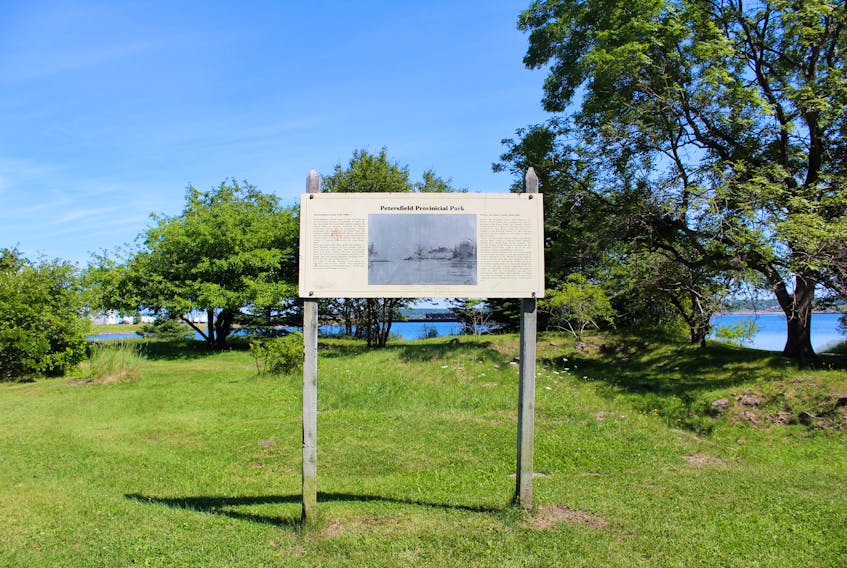SYDNEY, N.S. — Scumbag. Greasy. No-good son of a bitch. Asshole. An 18th-century mafioso.
That’s how some local historians describe David Mathews, one of Cape Breton’s colonial forefathers and a man who stopped Lt. Gov. Joseph F.W. DesBarres from sharing supplies with starving settlers, feuded so bitterly with early populist leader Rev. Ranna Cossit that his body wasn’t allowed to be buried in the church graveyard, and even plotted to assassinate George Washington.
‘PROFLIGATE, ABANDONED, AND DISSIPATED’
Before he fled here with other Loyalists at the end of the American Revolutionary War, Matthews was the last British-appointed mayor of New York City.

Pam Newton and her husband David Newton detail many of his misdeeds — including his role in a failed plan to kidnap or kill Washington — in their 2010 book “They Came from Away: Yanks, Brits and Cape Breton.” The chapter is titled the Cantankerous Mayor, but Pam Newton uses a different adjective for Mathews.
“He was a scumbag,” she told the Cape Breton Post.
“He wasn’t a very pleasant guy.”
The Newtons included several quotes from Thomas Jones, a Supreme Court judge and fellow Loyalist who was a contemporary of Mathews in New York.
Jones accused Mathews of misappropriating public money, using money from rents and ferries to support his lavish lifestyle, writing that Mathews “wallowed in luxury, and rioted upon plunder illegally and unjustly extorted from His Majesty’s loyal subject within the lines, to whom on every occasion he behaved with all the haughty superciliousness of a Turkish Bashaw or a proud, overbearing Highland Scottish Laird.”
Jones also mocked Mathews’ skills as a lawyer, calling him a “mere ignoramus in matters of law…as any common packhorse in the country” and describing him as a “person low in estimation as a lawyer, profligate, abandoned, and dissipated, indigent, extravagant and voluptuous.”
STARVING SETTLERS
That reputation preceded Mathews when he arrived in Nova Scotia and began petitioning for a prominent position in the colony, says Donnie Antle, who researched and hosted the recent 10-part radio documentary series “The Story of Home — Cape Breton’s Cultural Diversity” for the Coast 89.7 FM.

“I would say greasy, that’s what I would call him based on my research. When he came up here he originally landed in Halifax and he wanted to be attorney general of the mainland colony of Nova Scotia, and they had heard of him before and didn’t want him in that role, so he moved further up to Cape Breton and landed here.”
According to author the late Robert Morgan, a noted Cape Breton historian and author, Mathews was eventually persuaded by Abraham Cuyler, a former mayor of Albany, to move to Sydney, where he was serving as registrar of the new colony of Cape Breton.

In July 1785, DesBarres appointed Mathews attorney general and made him a member of the powerful executive council that basically formed the only government in the colony.
It was a decision DesBarres would quickly regret. Mathews and Cuyler soon formed a faction on council that seemed to oppose him at every turn. And it soon cost him his position as head of the new colony.
Morgan writes that in December 1785, DesBarres tried to commandeer food and supplies from Col. John Yorke of the 33rd Foot Regiment in order to feed the non-Loyalist settlers. Mathews and Cuyler took Yorke’s side and began working for DesBarres’s removal. They sent a petition to Nova Scotia Gov. John Parr, who was DesBarres’s immediate superior. Parr forwarded the petition to London and DesBarres was recalled the following November.
Old Sydney Society executive director Joyce Rankin doesn’t hold back when asked her opinion of Mathews.
“To me, he sounds like a complete asshole,” she said.
“There was a famine, and it was pretty universal — everyone was starving — and David Mathews wanted food to go only to the Loyalists. So that’s why he’s an asshole.”
AN 18TH-CENTURY MAFIOSO
With DesBarres out of the way, Mathews set his sights on his remaining enemies on the council. When William Macarmick became lieutenant governor in 1787, Mathews soon had his chief rival, Richard Gibbons, removed as chief justice, and Rev. Ranna Cossit rose up as leader of the anti-Mathews faction.
Jost House manager Jay Duguid has led hundreds of historic walking tours through Sydney and is very familiar with Mathews.Power shifted in Mathews favour in 1795 when Macarmick retired and Mathews, as senior councillor, took over as the colony’s administrator.

Within five days, Mathews found cushy positions for his sons, making David Mathews Jr. the acting attorney general and William Tryon Mathews provost-marshal. He then had his main opponents on council — Cossit, secretary and registrar William McKinnon and Chief Justice Ingram Ball jailed on debt charges.
“David Mathews was a no-good son of a bitch,” Duguid offered, bluntly. “He had it out for everybody and he got rid of a lot of guys. He was just a bad guy.”

One incident involving Ball shows how far Mathews went to intimidate his political foes. In September 1797, Ball was away from his home in what’s now known as Balls Creek, outside Sydney, when David Mathews and a gang of sailors broke in and accosted Ball’s wife. According to a letter cited by Morgan, some of the intruders "teized and tossed her about for some time" while others, including "a strumpet in their company," watched.
“He’s like an 18th-century mafioso,” said Laurie-Anne MacKinnon, a Jost House interpreter since 2002.
“They decided they needed to put some pressure on Ingram Ball to change his votes. They waited until he was away from the homestead and they went and paid Mrs. Ball a visit with a number of sailors and several ladies of the night, and apparently accosted her in her home for several hours. It didn’t go into details about what happened but very shortly after that Ingram Ball resigned from council. There was out and out intimidation and personal intimidation in order to get what he wanted. It was Mathews’ son who led the gang but you can infer that he had something to do with it because he ran his boys like his own enforcers.”
Word of Mathews’ conduct eventually got back to England and in June 1798 Maj.-Gen. James Ogilvie replaced him as administrator. Ogilvie launched an investigation but was unable to prove Mathews guilty of any unlawful activity before he left the following year.
Gen. John Murray took over from Ogilvie in June 1799 and also clashed with Mathews, eventually dismissing him as attorney general.
Mathews didn’t give up though. In January 1800, he appealed to the Duke of Kent, who replaced Murray with Maj.-Gen. John Despard. However, before he could work his way back into power, Mathews died in July.
REST IN PEAS
The bible might urge forgiveness, but Cossit still apparently held a grudge against Mathews.
He refused to allow his adversary to be interred in the courtyard at St. George’s Church. Instead, Mathews was buried at his estate in Amelia Point, which is now part of Petersfield Provincial Park in Westmount.

“We always say he’s over there resting in peas,” joked Duguid, referring to the Washington plot, which was apparently foiled when a bowl of poisoned peas meant for the Revolutionary War general spilled on the ground and the chickens that ate them died.
Aside from inspiring that bit of gallows humour and still drawing the scorn of people who study Cape Breton history, Mathews didn’t leave much else of a legacy.
While Washington has his monument, DesBarres is celebrated as Sydney’s founder with a statue overlooking the harbour, and Cossit’s original home is now Cossit House, a museum complete with costumed guides and authentic 18th-century artifacts, Mathews doesn’t even have a tombstone marking his grave and there doesn’t seem to be any existing image of his likeness.

A children’s playground in the Bronx borough of New York does partially bear his name. However, based on the inscription describing Mathews, it seems likely the New York City Department of Parks and Recreation named Matthews Muliner Playground for its location between Matthews Avenue and Muliner Avenue, rather than the man.
In part, it reads: “Mathews was installed as the Loyalist mayor. Mathews was known as a thief, an embezzler, and a spendthrift.”









